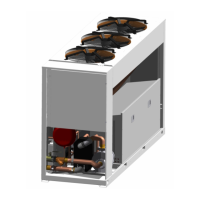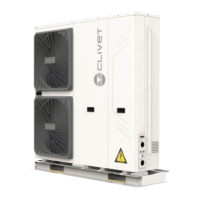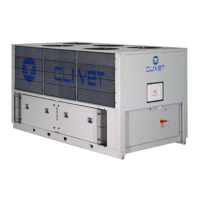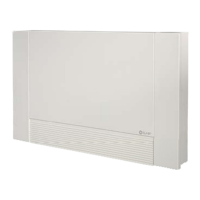25
®
GENERAL
ALL THE EQUIPMENT MUST BE COMMISSIONED BY AUTHORISED SERVICE CENTRES.
THIS SERVICE IS LIMITED TO START-UP OF THE UNIT ONLY AND NOT THE CONNECTIONS OR INSTALLATION OF THE
SYSTEM
PRELIMINARY CHECKS
BEFORE PERFORMING ANY TYPES OF CHECKS, MAKE SURE THAT THE UNIT IS PROPERLY INSTALLED AND CONNECTED
PRELIMINARY CHECKS: ELECTRICAL SYSTEM
CAUTION: Before performing the checks described below, make sure that the unit’s electrical power line is disconnected at the
source. Check that the isolator device is padlocked or hat the handle has been applied with a special sign caution against operation.
Before performing the electrical connections, check that no voltage is present using a voltmeter or phase indicator.
CHECKS TO BE PERFORMED WITH ELECTRICAL POWER DISCONNECTED:
- Check that the cross-section of the electrical power cables is suitable for the load of the entire unit (see the section on electrical
connections in the manual).
- Check that the unit has been earthed (see the section on electrical connections in the manual).
-· Check that the screws that fasten the wires to the electrical components in the panel are tight, to ensure adequate electrical contact
(during handling and transport vibrations may have loosened the screws).
At this point, the unit can be electrically powered by closing the isolator device installed upstream of the power line. CAUTION: Before
performing this operation, check that all the cut-out devices on the unit have been reset.
- Place the handle of the unit’s mains isolator device / circuit-breaker in the on position.
- Check that the electronic board / display on the terminal turn on (after a few seconds)
- Check that the unit is off (see the section on "Control" in the manual)
CHECKS TO BE PERFORMED WITH ELECTRICAL POWER CONNECTED:
- Check the value of the mains voltage supplied to the unit, which must fall within the following limits:
230 +/- 6%, single-phase units
400 +/- 6%, three-phase units
-·Check the unbalance of the phases. This must be lower than a maximum value of 2% (see calculation example).
Calculation example:
L1 - L2 = 398
L2 - L3 = 405
L3 - L1 = 395
The average of the values measured is calculated as follows:
(398+405+395)/3=399.3
The maximum deviation from the average is thus:
405-395=10V
The unbalance is thus:
(10/399.3) x 100 = 2.5% (non acceptable)
If compressor crankcase heaters are present, when starting the unit for the first time and after each extended shut-down, the heaters
that heat the compressor crankcase oil should be operated for at least 8 hours before starting the compressor.
CAUTION: IF THE CRANKCASE HEATERS ARE PRESENT, DO NOT START THE COMPRESSOR WITH THE CRANKCASE OIL
BELOW OPERATING TEMPERATURE. (THE TEMPERATURE OF THE COMPRESSOR CASING ON THE LOWER SIDE MUST BE
AT LEAST 10°C HIGHER THAN THE OUTSIDE TEMPERATURE).
The units are activated according to the phases described below:
1 - Close the circuit breakers or the isolating switch on the unit.
2 - The unit will not start operating until the operating mode is selected on the keypad, therefore, as seen in the diagram, the
crankcase heater will be powered only for the time required to allow the compressor to reach the desired temperature.
Start-up
- START- UP -
PRELIMINARY CHECKS: REFRIGERANT CIRCUIT
- Visually check the refrigerant circuit. Any oil leaks may have been caused during transport.
- Check that the refrigerant circuits are pressurised (using the pressure gauges on the machine, or test pressure gauges).

